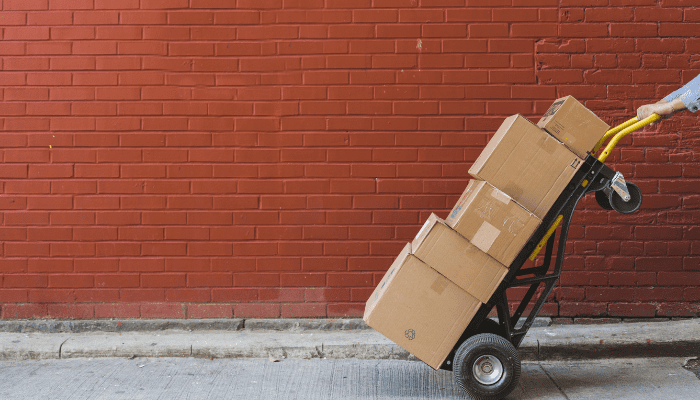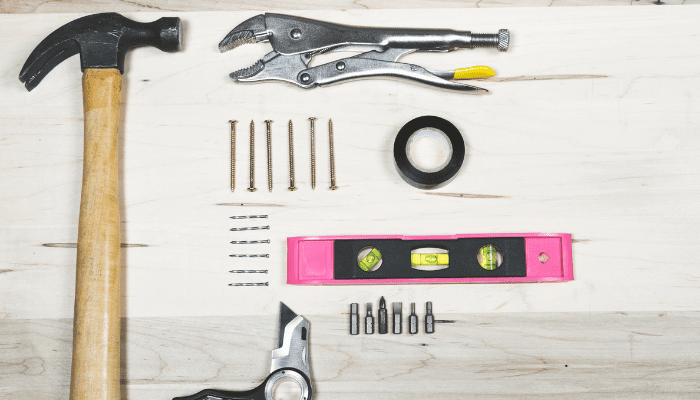It’s time to move into your new place. And this time, you’re doin’ it yourself.
Instead of hiring professional packers and movers and drivers, you’ve decided to DIY this massive task. But your buddies, bribed with all the pizza in the world, won’t be able to pull this off if you don’t have the right tools.
So we talked to Rich Hernandez. As a top real estate agent in Southern California with 15 years of experience, he’s witnessed a lot of moves, and he shared some insights with us for the DIY mover.
His first piece of advice: “Do not pack the day of moving.”
Hopefully, we’re all aware of that rule of thumb. In fact, if you’ve ever moved, you probably felt a jolt of panic just from reading that sentence. Moving is one of the most stressful life events we humans experience, so you want to be prepared with plenty of time — and plenty of useful tools.
Hernandez also shares a more down-to-earth anecdote about DIY moving tools: The moment his dad gave him a dolly.
“My father made me, I’m gonna say probably 10, 15 years ago, a little dolly that’s made out of two-by-fours and it’s about … four-by-four, big old wheels on the bottom,” he says.
This dolly, covered in carpet, festooned with thick “dock rope,” and beaten up from several loads of furniture, is such a useful tool that, in addition to using it himself, he offers it to his clients for their moves. He likes this practice because it’s “another touchpoint for me to be able to be of service.” This heirloom dolly has utilitarian as well as emotional value: “It’s cheap, it’s ugly, it’s used, but it’s from my dad, you know what I mean?”
A moving tool doesn’t have to be pretty — or even state-of-the-art — to provide loads of help with your DIY move. In this article, we’ll walk you through a few dozen of the most useful tools for making your DIY move seamless (and as stress-free as humanly possible).

Tools for moving big stuff
“Give me a lever and a place to stand,” declared ancient physicist Archimedes, “and I can move the world.”
Was he talking about moving the world into his new condo? History is silent on this detail, but Archimedes would be proud of the simple tools available to help you move in modern times.
Dollies
These wheeled platforms come in a variety of designs tailored to what item you need to move, and where you need to move it. They’re also important to avoid damaging your old place on your way out. If you’ve sold your home, and then you scrape up the floors with your poorly pushed couch legs, “the seller is ultimately responsible” for any repairs, says Hernandez.
Furniture dolly: the simple, low, platform-on-wheels like the one Hernandez’s dad made him, great for pushing couches around.
Utility dolly (or “hand truck”): an upright, L-shaped dolly, great for more vertical items or stacks of boxes (plus, it allows you to stand upright while you’re pushing).
Stair roller: a specialized upright dolly with two sets of three wheels that rotate in tandem to roll your items up and down stairs.
Panel mover: a dolly fitted with vertical walls to transport wide, flat pieces, like framed art or glass tabletops or mattresses/box springs. (A panel carrier is a handheld hook to help with lifting this shape of item.)
Moving straps
These are essentially a system of straps that allow two people to lift dressers, appliances, and other items that seem like they should be way too heavy to lift so easily. You and a friend can feel like a pair of super-strong cartoon ants, invading a picnic and making off with a massive sandwich several times your body weight.
Moving straps can be found under various brand names like the Forearm Forklift and the ShoulderDolly.
Stretch wrap
Wrap your living room chairs: cushions and all. Keep a rolled-up rug from unrolling. Anything that needs to be kept together for easier moving can be cocooned in this material.
Tools for moving small stuff
Boxes, boxes, and more boxes. There never seem to be enough of them. Luckily, you can get them free if you know where to look.
But a box is just the beginning when you’re doing your own packing. Make sure you have the right accessories so your smaller possessions are sealed in, stacked up, labeled, and cushioned.
- Tape (packing tape and duct tape for sealing, low-tack tape for labeling)
- Label maker
- Zip ties and twist ties
- Bags
- Garbage bags for lugging last-minute, non-fragile items — and for tossing garbage!
- Vacuum storage bags so your comforters and sweaters take up less space
- Garment bags to protect dressier clothes from wrinkles
- Packing materials (packing paper, foam peanuts, bubble wrap)
You’ll also want some canned air. In the movie “It’s a Wonderful Life,” a young and optimistic George Bailey says, “I’m shakin’ the dust of this crummy little town off my feet and I’m gonna see the world.”
Why move into a new house if your electronics and other devices are coated with the dust of your old place? Canned air is a great way to blow the dust off your laptop keyboard, TV cords, and power strips — and you don’t even need a time-traveling guardian angel.

Tools for turning big stuff into small stuff
Your bookshelf, your china cabinet, your 2/3-size replica of Shakespeare’s Globe Theatre … You might have some large items that can be dismantled for easier transport. In this case, it’s good to have:
A set of hand tools
- Screwdrivers
- Hammer
- Wrench
- Other simple items like a flashlight or putty knife that will stay useful in your new home
You’ll find a wide range of offerings to choose from. How basic or extensive of a set you get is completely up to you.
A consideration: move or remove?
Maybe your massive TV cabinet is outdated. It’s fitted with slots to hold VHS tapes, and it isn’t going to get any more use. Why lug that thing around?
“Before you move is the time to kind of go through and anticipate what you’ll need, what you don’t need,” says Jennifer Frank of Jennifer Frank Professional Organizers in suburban Chicago, who reminds us that sometimes the most valuable moving tip is deciding what not to move. “It’s silly to move stuff you know you don’t need, love, or use.”
“If you haven’t used an item in the last six months or a year, you can probably safely let it go,” she says.
Frank offers an obvious exception for valued heirlooms (like Hernandez’s homemade dolly cart!). “If it’s … a kitchen tool that you use once a year to make your grandma’s famous whatever-kind-of-cookies, that is understandable [to hold on to],” she tells us. But gadgets you’ll never use again? “Those are safe to let go.”
What if the item in question was a gift? It’s still ok to get rid of it.
“People don’t give you gifts to make you feel guilty,” Frank says. “They want you to be happy, and if it doesn’t make you happy and it’s not useful, it’s not going to hurt their feelings if you let it go.”
The bottom line, she says, is that if you don’t use an item in your current home, you’re unlikely to use it in your new one. So maybe you can use those hand tools in a cathartic stress-relieving ritual of dismantling a huge, no-longer-useful item and leaving it behind to begin your new life!
Checklists
This brilliantly low-tech tool is recommended by Laura Tatar of Laura Tatar Coaching as a way to keep track of tasks — and to visualize your progress. “Write out lists of items you need to buy, folks you need to get in touch with, errands you need to run, or scheduling you need to finalize,” she tells us. “Also, as you cross things off the list, you can see the things you are achieving and are likely to feel more motivated and accomplished.”
If you need a little help, you can turn to the pros for a premade checklist. Just print it out, grab your lucky pen, and you’re ready to go.
The tool of cash
Yes, those green slips of paper people in bygone eras used to pay for things. They can come in handy for moving-day water bottles, snack breaks, quick trips to the hardware store, and tips for whoever’s driving the van.
“Make sure [you] get cash on hand when [you’re] moving that day, because you always are going to need cash,” Hernandez tells us.

The tool of community
“Knock on the door, because you want to know your neighbors,” Hernandez advises, sharing another less-than-obvious moving tool. “They’re around, they’re seeing you, it’s just better … if you go meet them.” Human interaction is a valuable tool for the people you’re going to share a block with.
The biggest tool of all: a truck
While a rule of thumb is that it’s a good idea to start planning your truck rental about eight weeks before you move, Hernandez has a word of caution: don’t schedule your truck “until your Realtor® says yes, it’s time.”
He says he’s seen buyers “schedule their moving truck … and the timing doesn’t add up because there are things that happen during the transaction, or it just doesn’t close at the exact time.”
The bottom line: Make sure you time it right. Rent a truck too early, and you could end up sitting on a truck full of furniture, waiting for your closing to go through. Rent it too late, however, and you could find yourself scrambling at the last minute to find an affordable truck — or any truck at all.
Renting a truck for a small, local move should cost an average of $130. A long-distance move can cost about $1,780. For comparison, hiring movers to make these same moves could cost more than twice that: up to $1,500 locally and up to $5,600 long distance.
While you wait for the go-ahead, equip yourself with these tools to get things on that truck — and secure them in place.
- Elastic straps
- Ratchet straps
- Bungee cords, cargo straps, ropes
- Moving blankets to toss over larger object and pad them on the journey
- Truck loading ramps
- Ramps for doorways and curbs
- Door stoppers

Tools for unpacking
Once the move is done, your journey is only half over. Now it’s time to make yourself at home in your new place. These items will get you set to take apart your boxes, hang up your art, and write your new chapter.
- Box cutter
- Scissors
- Step ladder
- Measuring tape
- Laser level and stud finder to hang art, shelving, wall-mounted TVs, etc.
- Drywall anchors to hang heavy objects on drywall where a stud isn’t accessible
- Paintbrushes
- Shoe covers
Hopefully, the prospect of a DIY move is less intimidating now that you’ve met these helpful tools. Have we whetted your appetite for a move you can pull off yourself? Contact a top HomeLight buyer’s agent today and find your next home.
Header Image Source: (janelyn young / Unsplash)
